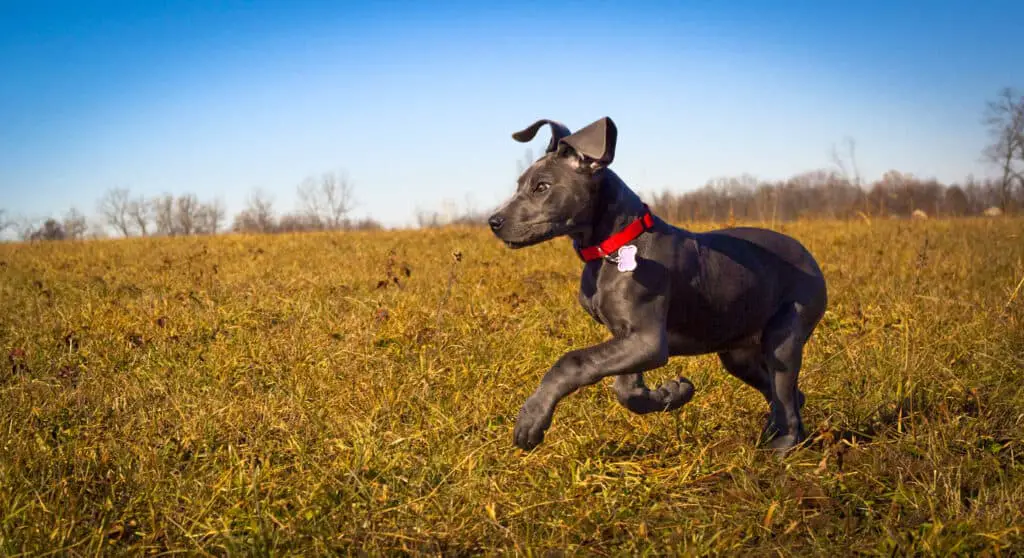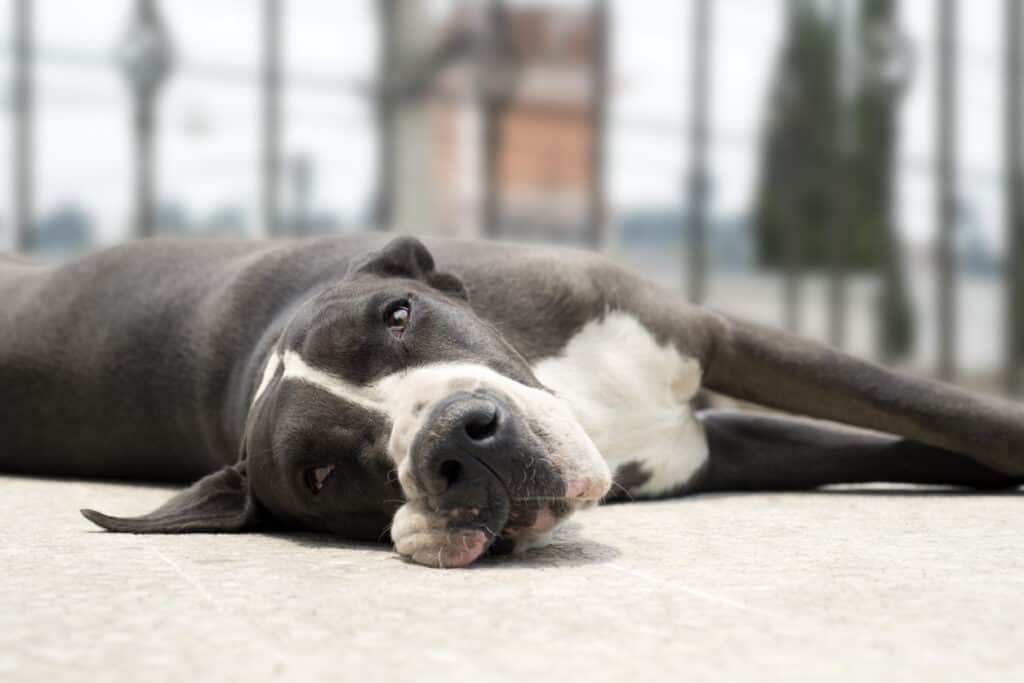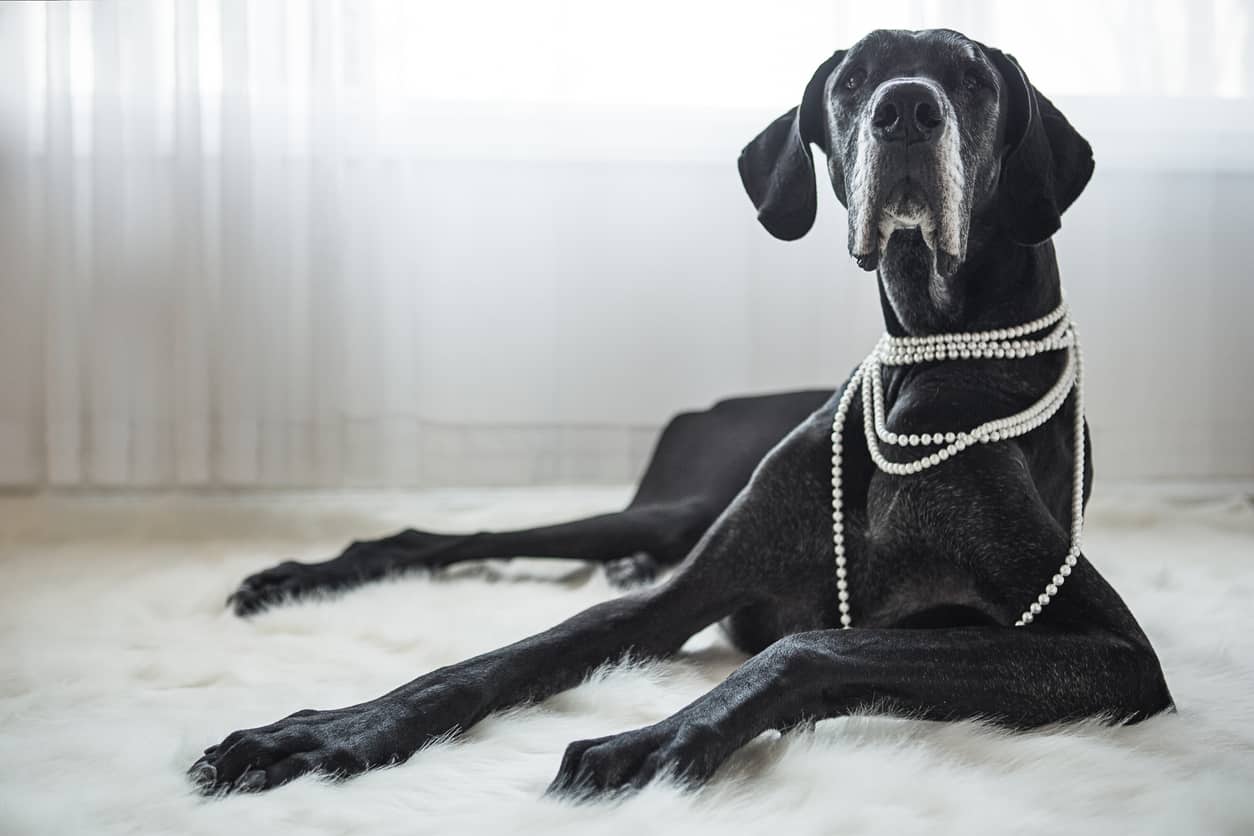Great Danes are enormous companions with a reputation for being gentle giants. They are fondly referred to as “nanny dogs” because they make such excellent family pets, and they are one of the most popular dog breeds in the United States. If you are thinking of welcoming a Great Dane into your home, one of the first questions you might have about this popular breed may be with regard to its energy level – just how much exercise does a Great Dane require? Are Great Danes hyper? Do Great Danes get the zoomies?

These are important questions for prospective dog owners of any breed to ask themselves, but particularly where Great Danes are concerned due to their enormous size, even as puppies.
Great Danes are a mix of energetic and laidback. They can certainly get a case of the zoomies and love to race around the yard in a fit of excitement, and they also enjoy playing with other dogs.
When properly socialized, Great Danes are friendly and curious with new humans and dogs, and their gentle nature extends to other creatures too.
Great Danes are not known for being very self-aware with regard to their size. Because of this, they need to be carefully supervised during interactions that cause excitement from the time they’re puppies. Naturally, most interactions are exciting to puppies, so it is normal for owners to feel that they are constantly correcting and teaching their Great Dane puppy how to engage politely and nicely with others.
For as unaware as they are about their size, Great Danes are extremely sensitive when it comes to their training. They do not respond well to a harsh tone of voice or physical punishment and are liable to become stubborn and ornery if they feel they have been mistreated. (To be fair, sometimes they will decide to be stubborn and ornery just because they can. This kind of behavior is most typical in adolescent Danes who are in the peak of their extended growth phase.) So, patience is essential for owners committed to raising well-mannered Great Danes and providing constructive guidance when their Great Dane exhibits high energy levels that result in inappropriate behavior.
Great Dane energy levels as puppies
When your Great Dane is a puppy, it will probably have the highest amount of energy that it will have throughout its life. Much like human children, Great Dane puppies can seem to have an endless capacity for fun and running around, sometimes to the chagrin of their owners! However, all Great Danes are different, and for this reason there can be quite a range in exercise requirements from puppy to puppy. For example, some Great Dane puppies may only require half an hour of playtime each day, while other may require up to two hours of varied and stimulating play – yikes!

Fortunately, there are many ways to incorporate your Great Dane puppy’s need for exercise into their daily routine, in which you teach them how to follow the rules of your home, walk nicely on a leash, bring the ball back to you in the yard, meet and engage with strangers, and so much more. In preparing to manage your Great Dane’s energy, you can also create a naptime routine for them – they’re sure to pass out after their energetic bursts!
Ensuring that you can provide the space a Great Dane needs in which to live comfortably can be a key component to managing their energy. Great Danes require a moderate amount of exercise when they’re full grown, but this is contingent on them having the space they nee to sprawl out and relax at home. Otherwise, they may become a little claustrophobic and squirrely as a result of lack of space.
When you bring a Great Dane puppy into your home, you may have all sorts of ideas for how to work out all of their energy! After all, they’re eating anywhere between 2,500 and 3,000 calories idea, so surely there’s no limit to what they can do when they’re in the mood to work off all those calories, right? Well, different outlets for energy are great, but there are some important limitations to place on your Great Dane puppy’s exercise related to protecting their still-developing skeletal frame.
Great Dane puppies go through an extended growth period, the most significant of which occurs during the first year of life. During that first year, a Great Dane will put on around 100 pounds. Attention to their development is critical in order to prevent developmental issues with their still-growing bones and joints. While the majority of this attention is paid to the type of food you provide them (as well as how much and how often), it cannot be overstated how ill-advised it is to take Great Dane puppies on runs when they are still growing. Great Danes do not finish growing until around two years of age, and depending on their development, they may not be their full size and mass until three years of age.
It is critical to provide your Great Dane puppy with soft-impact exercises while they are growing. This will ensure that they become strong and healthy, and protect the fragile bones and joints. It is helpful to have a yard with soft grass on which your puppy can run around and play – soft impact does not just refer to the intensity of the exercise. Soft impact also refers to the ground that the Great Dane puppy plays on.
If you don’t have a yard to work out your Great Dane puppy’s exercise, a dog park is a great alternative once your puppy is up to date on all mandatory vaccinations. Dog parks have lot of space to run around and are typically situated on grassy land. Dog parks also provide the added benefit of providing opportunities to socialize your Great Dane, a component of raising any dog that is especially important when working with Great Danes due to their high adaptive intelligence, which means they have a natural affinity for being exposed to new situations and learning about how to behave appropriately depending on the circumstances.
Older Great Dane’s Energy Levels

Once your Great Dane is over two years old and mostly or completely physically filled out, you can introduce running into their exercise regimen. It should be noted that Great Danes are not designed to be long distance runners, nor are they designed for intense sessions requiring endurance. Historically, the breed was used during boar hunts to chase after and catch wild boar so that their masters could come and finish the hunt. This required much more courage and strength than anything else, but Great Danes do have a natural affinity for jogging at their own natural pace. Indeed, jogging an adult Great Dane provides a more natural expression of its loping gait and should be encouraged in those that are healthy and done growing.
Jogging with a Great Dane would be best undertaken on local trails with soft earth underfoot – this would ensure that the exercise remains as low-impact as possible and also serve to help strengthen the very skeletal framework that is at risk of being harmed by this activity earlier in life.
If you want to jog with your Great Dane, you’re going to want them to be respectful on a leash. Leash training can seem challenging when they are rambunctious puppies, but it’s one of the most important training investments that you will make because walking your Great Dane is an absolutely inescapable aspect of your relationship as a dog owner and dog. Fortunately, because puppies have short attention spans, their lessons couldn’t be very long even if their owners have the time. Thus, leash training can be done multiple times a day in 10-30 minute blocks, depending on how often you’re taking your Great Dane puppy out and for how long.
When it comes to exercise and food, this breed does best when the amounts are spread out in smaller chunks. When it comes to exercise, regular excursions spread out throughout the day also serve to keep your Great Dane calm by regulating its energy level. This is a very good thing because a calm dog is a happy dog, and calm and happy dogs are less likely to contract certain illnesses and conditions that can sometimes be triggered by anxiety and stress.
There are many exercises you can do with your Great Dane to release their energy and foster a sense of calm in them. In addition to walks and age-appropriate jogs, you can also play fetch and take your Great Dane on hikes. With regard to hiking, similar considerations to running must be made with respect to the intensity and duration of the hike (Great Danes are not designed to handle long, technical, or very challenging treks, but a happy young adult will happily accompany you on a long hiking ramble).
With regard to infamous Great Dane zoomies, these will happen less frequently as your Great Dane gets older, but they remain a regular exhibition well into adulthood. It is of course not recommended to allow your Great Dane to tear around your house because of the damage to household items or risk of injury to unsuspecting children or elderly people. However, if you are able to offer your Great Dane a yard, the zoomies can simply come to signal an impending long nap – quite often, after one or two minutes of sprinting around, your Great Dane will flop down onto its bed to rest and snooze the rest of the afternoon away.
Finally, when it comes to managing your Great Dane’s energy, an oft-overlooked component is to examine the energy you personally bring to your environment. Are you a naturally relaxed and confident individual, or do you suffer from anxious spells? Being self-aware can help you learn how to be the best canine leader that you can be for your Dane, who will naturally look to you in situations of confusion or novelty. Just as children observe their parents, dogs observe their owners. By recognizing that you will have a pair of loyal and loving eyes on you at all times, you can learn to become more conscious of how your actions (and reactions) may influence your Dane’s own behavior.
In some cases, even with the modeling of a calm and confident owner, a Great Dane may simply be a more anxious animal as a baseline. In this situation, you must learn to be sensitive to their needs, as well as to anticipate. Unlike our human partners and friends, Great Danes cannot verbalize their exact needs when they are uncomfortable or frightened, but by becoming adept at observing their behavior and always remembering to check in with the, anyone can be a good owner to a more naturally anxious or shy Great Dane. The bottom line is that a Great Dane that has a trusting and loving relationship with its owner is more likely to have predictable energy patterns.

